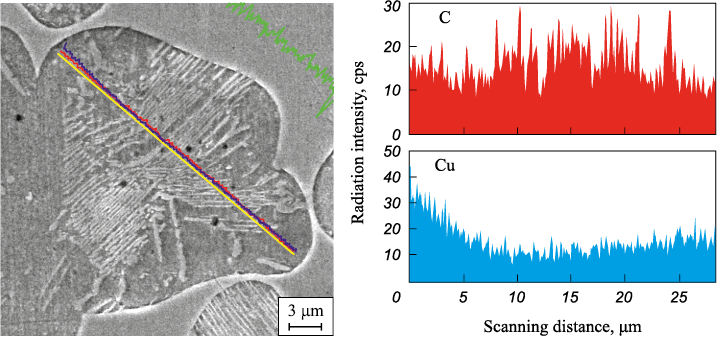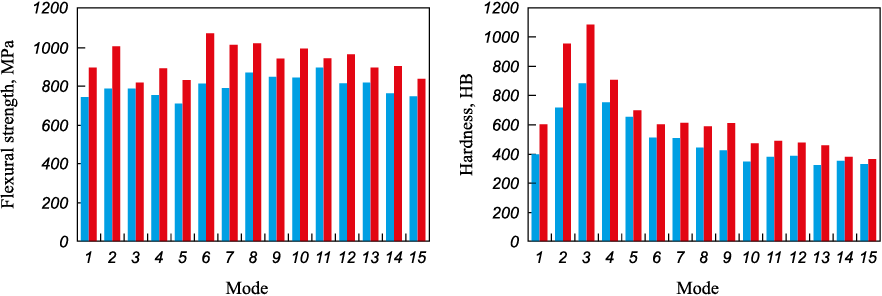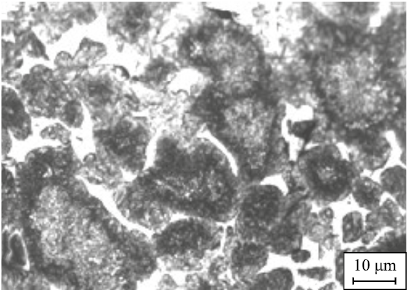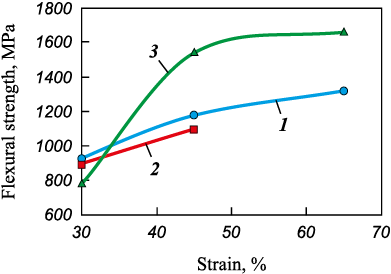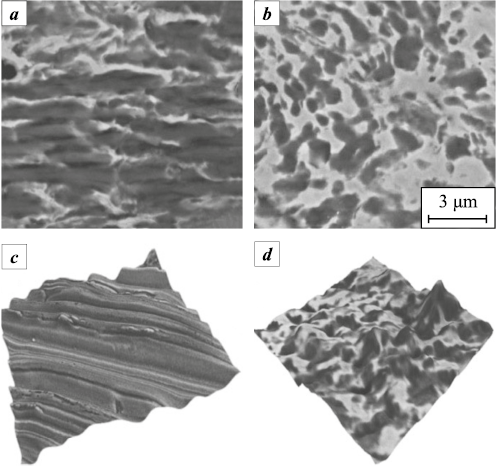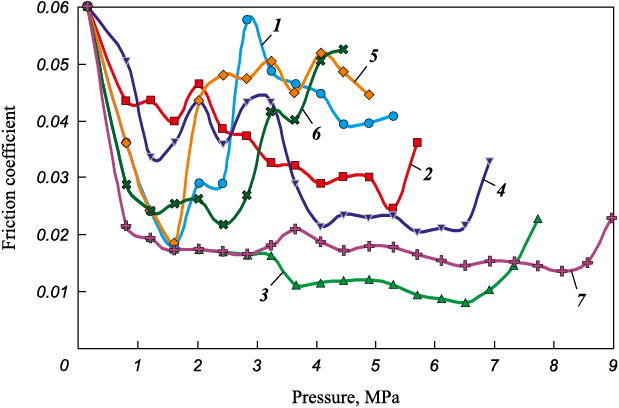Scroll to:
Iron-based pseudosalloys for antifriction applications with enhanced mechanical and tribological properties developed at the O.V. Roman Powder Metallurgy Institute of the National Academy of Sciences of Belarus
https://doi.org/10.17073/1997-308X-2025-4-16-27
Abstract
The paper presents the results of research carried out at the O.V. Roman Powder Metallurgy Institute (Belarus) on the production of iron-based pseu-dosalloys for antifriction applications and the development of methods for im-proving their mechanical and tribological properties. A computational model of parametrically non-stationary high-temperature infiltration was developed, enabling the calculation of pore-filling time and optimization of the pseudosalloy fabrication mode. The features of carbon distribution in the iron skeleton of the pseudosalloy during isothermal holding and subsequent heat treatment under the influence of the copper phase were identified. It was shown that after isothermal holding, the carbon content in the region of the skeleton adjacent to the copper phase is lower than in its center, whereas after quenching and high-temperature tempering, a carbon-enriched zone forms at the interface with the copper phase. The mechanisms responsible for improving the mechanical and tribological prop-erties of pseudosalloys using the developed methods were established. These in-clude: stamping at the optimum temperature; extended holding during high-temperature tempering after quenching; high- and low-temperature thermome-chanical treatments under optimized conditions; alloying the iron matrix with nickel or chromium; and structural modification through the introduction of ul-tradispersed diamonds, ultradispersed aluminum oxide, nanodispersed zirconium oxide, mixtures of nanosized oxides of iron, nickel, and zinc, single- or two-phase aluminides of nickel, iron, or titanium and their composites, calcium molybdate, or hexagonal boron nitride, as well as alloying the infiltrate with tin, nickel, or chromium and the addition of ultradispersed aluminum oxide. The obtained strength, hardness, impact toughness, friction coefficient, limit seizure pressure, wear resistance, and PV parameter values are reported. The wear mechanism of pseudosalloys with enhanced properties was determined. It was demonstrated that during friction, nanoscale porosity and voids form, serving as additional res-ervoirs for lubricant, thereby improving friction conditions, preventing copper transfer into these areas, reducing the coefficient of friction, and increasing wear resistance.
Keywords
For citations:
Dyachkova L.N., Vityaz P.A. Iron-based pseudosalloys for antifriction applications with enhanced mechanical and tribological properties developed at the O.V. Roman Powder Metallurgy Institute of the National Academy of Sciences of Belarus. Powder Metallurgy аnd Functional Coatings (Izvestiya Vuzov. Poroshkovaya Metallurgiya i Funktsional'nye Pokrytiya). 2025;19(4):16-27. https://doi.org/10.17073/1997-308X-2025-4-16-27
Introduction
This article is dedicated to the memory of Oleg Vladislavovich Roman – the founder of powder metallurgy in Belarus, the first Director of the Powder Metallurgy Institute, and the first General Director of the State Research and Production Powder Metallurgy Association. His main scientific interests included theoretical and experimental studies of impulse processes in materials processing, such as explosive welding. At the same time, he devoted considerable attention to the theory and practice of classical powder metallurgy processes, in particular, the development of powder-based antifriction materials with enhanced mechanical and tribological properties for components of heavily loaded friction units. The present article continues this line of research.
In heavily loaded friction units operating under high pressures and across a wide temperature range, a thin boundary lubrication film does not adequately protect the surface of sliding bearings from plastic deformation, leading to a marked increase in wear [1]. Therefore, antifriction materials must combine high bulk mechanical strength with stability at operating temperatures, advanced tribological characteristics, and high thermal conductivity for efficient heat dissipation from the friction zone. They must also exhibit corrosion resistance and oxidation stability at elevated temperatures. Consequently, minimal porosity is a primary requirement.
Powder antifriction materials based on iron have found the widest application in heavily loaded friction units, owing to their high wear resistance and permissible load capacity. To increase their strength, alloying with carbon, copper, manganese, chromium, nickel, molybdenum, and other elements is employed, along with heat treatment and thermochemical treatment [2]. A low coefficient of friction and high wear resistance are achieved by introducing solid lubricants and various solid ultra- or nanosized inclusions (carbides, borides, oxides, glass, intermetallics, etc.) [3]. Porosity reduction methods include plastic deformation processes, hot dynamic or isostatic pressing [4], and sintering in the presence of a liquid phase [5].
A particularly promising method for reducing porosity and enhancing the mechanical, tribological, and thermal conductivity properties is the infiltration of an iron skeleton with copper alloys [6], producing so-called pseudosalloys. In addition to the properties listed above, they are also characterized by high thermal and heat resistance, damping capacity under vibrational loading, resistance to electrical erosion, and thermal stability. Pseudosalloys are used to manufacture both antifriction and structural components.
The aim of this article is to review the studies conducted at the O.V. Roman Powder Metallurgy Institute on the production of iron-skeleton-based antifriction pseudosalloys and the development of methods for improving their mechanical and tribological performance.
Research methodology
The powders of iron, copper, tin, and graphite (commercial grade) were used in the as‑received state. The additives introduced to improve the properties are described below. A hydraulic press was employed for compaction, and a continuous furnace with an endogas atmosphere was used for infiltration.
The material structure was examined using a MEF‑3 metallographic microscope (Austria) and a high-resolution Mira scanning electron microscope (Czech Republic) equipped with an INCA 350 micro‑X‑ray spectral analyzer (UK). The phase composition and fine structure were studied on an Ultima IV Rigaku high-resolution diffractometer with a cobalt anode (Japan) under CuKα radiation. Mechanical properties were determined using standard methods, while tribological characteristics were evaluated on an MT‑2 friction testing machine at a sliding speed of 2.5–7.0 m/s. Tests were carried out on three samples (10 mm in diameter, 12 mm in height) with a moderate lubricant supply (6–8 drops per minute of industrial oil I‑20) directed to the center of the counterbody. The wear of the samples was measured on an optimeter with an accuracy of 0.001 mm. Hardened steel 45 discs (42–45 HRC) were used as the counterbody.
Results and discussion
In studying the processes of pseudalloy fabrication, a computational model of parametrically non‑stationary high‑temperature infiltration was developed. The model accounts for changes in the structural parameters of the skeleton and in the physical properties of the liquid phase, caused by diffusion, dissolution, and liquid‑phase rearrangement of skeleton particles. The model showed that, depending on pore size and infiltrant viscosity, capillary forces fill the pore space with copper alloy within 30–60 s [7]. However, this time is insufficient for the formation of a stable skeleton structure, particularly in the case of unsintered skeletons, which prevents achieving the required material properties. Therefore, isothermal holding at the infiltration temperature was applied. During this process, a homogeneous skeleton structure, the required morphology of the copper phase, and transition layers in the interfacial regions (Fe solid solution in Cu and Cu solid solution in Fe) are formed, and micropores are also filled with copper alloy. These phenomena provide high strength, wear resistance, thermal conductivity, and a low friction coefficient [8; 9], thus confirming the validity of the proposed antifriction material model.
The presence of copper in the pseudalloy significantly affects the formation of the skeleton structure of carbon steel during isothermal holding, especially when infiltrating an unsintered skeleton, where the formation of the Fe–C solid solution and the infiltration process occur simultaneously. As shown previously [10], copper located at the particle boundaries of the skeleton slows down grain‑boundary diffusion of carbon into iron and drives carbon deeper into the particles. As a result, the carbon content in the layer adjacent to the copper phase is lower. Micro‑X‑ray spectral analysis revealed that in the regions of the steel skeleton near the copper infiltrant, the intensity of the carbon signal was more than two times lower than in the center of the steel skeleton (Fig. 1).
Fig. 1. Microstructure of a section of the steel skeleton of a pseudalloy with a skeleton |
The microstructure obtained after infiltration and isothermal holding ensured high performance. Depending on the skeleton composition as well as the composition, content, and morphology of the infiltrant, the tensile strength was 400–600 MPa, impact toughness 30–40 kJ/m2, hardness 140–280 HB, and thermal conductivity 45–79 W/m·K. Under boundary lubrication at PV = 30–38 MPa·m/s, the wear rate was 0.08–0.20 μm/km – more than five times lower than that of dense bronze. The friction coefficient was 0.007–0.009, and the maximum operating temperature reached 800 °С.
To further improve the properties of the pseudalloys, plastic deformation (hot die forging), heat treatment, and thermomechanical treatment were applied. Hot die forging at the optimum temperature of 850–900 °C eliminated residual porosity and increased the tensile strength to 670–980 MPa, while hardness and impact toughness rose by a factor of 1.5–2.5 [11].
After quenching, depending on the copper‑phase content, maximum strength was achieved at tempering temperatures of 550–650 °C (Fig. 2) [12]. Extending the holding time to 3 h at these temperatures further increased the hardness of the pseudalloys, particularly those with a higher copper content. This effect is attributed to aging in the copper phase due to the precipitation of Fe4Cu3 intermetallic and copper–tin compounds (Table 1). As a result, the microhardness of the infiltrant phase increased from 1450 to 1750 MPa. At high‑temperature tempering, carbon diffuses into the more defect‑rich region adjacent to the copper phase, forming a carbon‑enriched layer (visible as a dark rim in Fig. 3). In high‑carbon steel skeletons, carbon segregation within the grain interior was less pronounced. The microhardness in the particle center was 3030 MPa, while in the dark rim zone it reached 4120 MPa.
Fig. 2. Effect of heat treatment modes (1–15) on the properties of a pseudalloy
Table 1. Phase composition of material with a PK80 steel skeleton infiltrated
Fig. 3. Microstructure of a pseudalloy with a skeleton | |||||||||||||||||||||||||||||||||||||||||||||||||||||||||||
The formation of a two‑layer structure in the pseudoalloy skeleton after heat treatment, together with aging of the copper phase, enhanced not only the mechanical but also the tribological properties. The seizure pressure doubled, wear resistance increased by more than 2.5 times, and the PV parameter rose by 1.5–1.7 times.
Application of thermomechanical treatment (TMT) further improved the properties of the pseudoalloys [13]. Deformation during TMT was carried out by free upsetting on a mechanical press with a strain of ε = 30, 45, and 65 % at 900 and 700 °C (high‑temperature thermomechanical treatment, HTMT) and at 550 °C (low‑temperature thermomechanical treatment, LTMT). Heating was performed by high‑frequency currents, and quenching after deformation was carried out in water. At HTMT with 900 °C and a strain of 65 %, samples fractured due to high stress levels at the Fe–Cu interphase boundaries. At HTMT at 700 °C, softening was less pronounced: the structure retained a well‑developed polygonal substructure of deformed austenite, which ensured higher strength.
The greatest strengthening was achieved with LTMT (Fig. 4), owing to hardening not only of the steel phase (formation of a two‑layer structure within grains, increased dislocation density, and development of a cell‑polygonal substructure) (Table 2), but also of the copper phase through aging.
Fig. 4. Effect of strain and deformation temperature during TMT
Таблица 2. Fine-structure parameters of the skeleton of PK80N4M steel
|
During TMT, macrotexture formation, structural refinement in the steel skeleton, and the development of an even more pronounced gradient structure compared with heat treatment were observed (Fig. 5).
Fig. 5. Microstructure of a pseudalloy with a skeleton of PK80N4M steel infiltrated |
The wear resistance of the pseudalloy after HTMT at 700 °C increased by 1.5 times at ε = 45 % and by 2.0 times at ε = 65 %. The seizure pressure increased by 1.9 and 2.1 times, respectively. After LTMT at 550 °C, wear resistance increased threefold at ε = 45 % and fourfold at ε = 65 %, while the seizure pressure increased by 2.4 and 2.5 times, respectively. The PV parameter after TMT was 1.8–1.9 times higher than without treatment.
A key advantage of iron‑based antifriction pseudoalloys obtained by infiltration with copper alloys followed by isothermal holding is the ability to tailor their properties by varying:
– the composition of the skeleton through alloying, microalloying, and the introduction of additives of different types;
– the composition of the infiltrant by alloying;
– the copper‑phase content, which is determined by the initial porosity of the skeleton;
– the morphology of the copper phase, which depends on the type of skeleton used – either a sintered skeleton with well‑developed interparticle contacts or an unsintered skeleton with more defective contacts;
– the duration of isothermal holding after infiltration.
Studies of wear intensity showed that the wear resistance of the pseudalloy was 3.0–3.5 times higher than that of sintered steel of the same composition as the pseudalloy skeleton [14; 15]. Micro‑X‑ray spectral analysis of worn counterbody surfaces paired with pseudalloys revealed that copper content reached 6–7 % due to selective mass transfer. The worn surfaces of pseudalloys were homogeneous, without signs of erosion (Fig. 6, a), and exhibited a spongy‑capillary structure (Fig. 6, b). Three‑dimensional images (Fig. 6, c, d) revealed the formation of nanoscale voids that act as additional lubricant reservoirs, improving friction conditions and preventing copper transfer into these areas. Copper was located only on the protrusions of the voids.
Fig. 6. Worn surfaces of samples made of sintered (а, c) |
Surface roughness studies of sintered and infiltrated samples showed that the initial roughness parameters differed by 30–40 %. After testing, vertical roughness parameters decreased 3.5–4.0 times for sintered materials and threefold for infiltrated materials [16; 17].
A significant increase in the strength of the steel skeleton was achieved by the introduction of:
• 2 and 4 %1 Ni or 3 % Cr [18];
• 0.2–1.0 % ultradispersed diamond (UDD) [19];
• 0.5–0.8 μm Al2O3 and 100–200 nm ZrO2 powders [20; 21];
• mechanically activated mixture of 300–500 nm Fe2O3 with 40–70 nm NiO and ZnO [22];
• single‑phase aluminides (Ni3Al, Ti3Al, Fe3Al), and two‑phase aluminides ((Al3Ni–Al3Ni2 ), (TiAl2–TiAl3 ), (Fe2Al5–FeAl3 ));
• TiCrAl, NiTiAl, and FeMo/TiB2 composites obtained by SHS with preliminary mechanical activation [10; 23];
• 3–5 μm CaMoO4 ;
• 2–8 μm hexagonal BN [24].
When ultradispersed mixtures of Al2O3 and ZrO2 oxides were added, strength, fracture toughness (from 31 to 40–43 MPa·m1/2), total fracture energy (from 1.7·105 to (1.8–1.93)·105 J/m2), and skeleton hardness (HV) (from 680–965 to 1100–1230 MPa) increased. This strengthening was attributed not only to grain refinement of the skeleton but also to the effect of ZrO2 nanoparticles at grain boundaries (Table 3). The most pronounced increase in strength of both iron and carbon steel (flexural strength increased by 50–100 MPa and compressive yield strength by 350–500 MPa) was observed when 0.5 % of the Fe–Ni–Zn oxide mixture was added (Table. 3).
Table 3. Compressive strength of sintered iron and PK80 steel
|
The dependence of strength on microadditive content was parabolic, with an optimum range of 0.2–0.5 %.
The greatest strengthening of powder steel, by a factor of 1.2–1.5, is achieved with the introduction of nanosized particles that form a denser, defect‑free contact with the matrix. Micro‑X‑ray spectral analysis showed that the introduced dispersed particles are located mainly along grain boundaries, where they retard collective recrystallization and promote grain refinement. The increase in strength of powder steel with the addition of 0.5 wt. % chromium boride is further explained by the fact that, during sintering, its particles interact with the iron matrix to form complex borides, and, by reacting with carbon, they form chromium carboborides.
The introduction of nickel, titanium, and iron aluminides also enhances strength and hardness by significantly refining the structure, with the degree of refinement depending on the quantity and composition of the additive. The most pronounced strengthening is obtained with 0.2–0.5 % FeMo/TiB2 or up to 5 % FeAl/Al2O3 , as well as with two‑phase iron aluminide and both single‑ and two‑phase nickel aluminides. The strengthening effect of FeAl/Al2O3 is attributed to the formation of alloyed regions with an austenitic structure, whereas FeMo/TiB2 promotes the formation of molybdenum solid solutions in iron and complex borides (TiFeMo)B2 . These borides exhibit a coherent interface with the iron matrix through transitional layers with variable element concentrations between the matrix and the aluminide particle.
Nickel aluminides increase strength more effectively (by a factor of 1.5–2.0) compared to titanium aluminides, while iron aluminide additions are even more effective. The strongest strengthening occurs with the introduction of intermetallics having lower melting points or polymorphic transformation temperatures (Ni3Al, Fe2Al5–FeAl3 , TiAl2–TiAl3 ). Tribological tests showed that aluminide additions reduce the friction coefficient of powder steel and significantly increase its seizure pressure (Figs. 7 and 8). The most effective additives in this regard were two‑phase nickel and iron aluminides.
Fig. 7. Dependence of the friction coefficient of PK40 (Fe–0.31–0.6 % C) powder steel
Рис. 8. Dependence of the friction coefficient of PK40 powder steel with additions |
Examination of powder steel without aluminide additions revealed wide seizure bands on the wear surface (Fig. 9, a). With aluminide additions, the surface was smooth (Fig. 9, b, c). In this case, micropores were formed on the surface, which gradually developed into voids acting as additional micro‑reservoirs for lubricant, thereby increasing wear resistance, as confirmed by micro‑X‑ray spectral analysis (Fig. 9, d).
Fig. 9. Worn surfaces of PK40 powder steel with and without intermetallic additions |
The introduction of calcium molybdate or hexagonal boron nitride increased the strength and wear resistance of powder carbon steels by ~30 %. In the first case, the effect was associated with the formation of CaO precipitates during CaMoO4 decomposition, which promoted structural refinement, while in the second case it was due to the formation of carboborides. Even greater effects of CaMoO4 and BN were observed in high‑chromium steels: the maximum increase in strength was 34 % in the first case and 2.1‑fold in the second [24].
The gas atmosphere also influences infiltration processes and the properties of iron‑based pseudoalloys. Increasing the hydrogen content in endogas slowed infiltration due to a reduction in the surface tension of the copper alloy. Introducing 25–50 % nitrogen into the endogas reduced the hydrogen and oxidizing components, which promoted a more uniform distribution of the copper phase in the pseudalloy and improved strength [25].
During contact infiltration, diffusion interaction of the iron skeleton with the compacted copper alloy caused erosion of the skeleton surface. To prevent this, specific additives to the infiltrant were developed and applied [10].
In the production of pseudalloys by infiltration of unsintered skeletons, methods were developed to accelerate diffusion processes in order to obtain a homogeneous skeleton structure and, consequently, higher strength. These methods are based on the introduction of high‑molecular compounds derived from polypropylene glycol (poly(diethylene glycol adipinate), polypropylene glycol adipinate, polypropylene glycol succinate, polypropylene glycol sebacinate) and on the use of alkali metal compounds (sodium, lithium). The latter promote the formation of atomic carbon through redox reactions during their decomposition in the heating process [10]. The most pronounced activation of diffusion of both carbon and alloying elements into iron was achieved by the introduction of alkali metal bicarbonates.
A study of the diffusion coefficient of carbon in iron, performed by radiometric analysis using the radioactive isotope C‑14 (in the form of ВаС14О3 or elemental C‑14) and the integral residue method, showed that the addition of sodium bicarbonate nearly doubled the diffusion coefficient of carbon. Transmission electron microscopy of foils in secondary and Auger electrons revealed that sodium formed nanodispersed ferrite‑type compounds Na3Fe5O9 . Owing to their strong affinity for grain boundaries, these compounds were located mainly along grain boundaries and structural heterogeneities, thereby hindering collective recrystallization and promoting the formation of a fine‑grained structure. In addition, because of its high affinity for metalloids, sodium interacted with impurities. Sulfur, phosphorus, and silicon were detected at sodium‑rich sites. This promoted the removal of impurity segregations from grain boundaries, thereby strengthening intergranular cohesion and increasing the strength of powder steels by a factor of 1.4–1.5.
The mechanical and tribological properties of iron‑based pseudalloys were improved not only by modifying the skeleton composition but also by alloying the infiltrant with Sn, Ni, Cr, or Pb, as well as by introducing Al2O3 particles with a dispersion of 400–700 nm [26].
All developed pseudalloy compositions and processing modes for producing friction unit components have been patented.
Conclusion
The processing modes for iron‑based pseudoalloys and the methods for improving their mechanical and tribological performance, developed at the O.V. Roman Powder Metallurgy Institute (Minsk, Belarus), provided the property levels required for reliable operation in heavily loaded friction units. A computational model of parametrically non‑stationary high‑temperature infiltration was proposed, which accounted for structural changes and property variations of the interacting phases. This model enabled calculation of pore‑filling times and optimization of infiltration parameters, including the use of extended isothermal holding.
It was shown that the copper phase plays a key role in structure formation within the steel skeleton of pseudoalloys during isothermal holding, heat treatment, and thermomechanical treatment. After isothermal holding, the carbon content near the copper phase was 0.2–0.4 % lower than in the central regions of the skeleton. Following quenching and high‑temperature tempering, a carbon‑enriched layer formed at the Fe–Cu interface.
A comprehensive set of approaches was developed to enhance the mechanical and tribological properties of iron‑based pseudalloys, and the mechanisms responsible for these improvements were identified. Increases in strength, hardness, impact toughness, seizure pressure, wear resistance, and PV parameter, along with a reduction in the friction coefficient, were achieved through the following measures:
– hot die forging at the optimum temperature (850–900 °С);
– extended tempering (550–650 °C) after quenching;
– HTMT at 700 °C with strain ε = 45–65 % or LTMT at 550 °C with ε = 45 %;
– alloying of the steel skeleton with 2–4 wt. % Ni or Cr;
– structural modification by introducing 0.2–1.0 wt. % ultradispersed diamond (UDD), ultradispersed Al2O3 (0.5÷0.8 μm) or ZrO2 (100÷200 nm), and mechanically activated mixtures of nanosized Fe (300÷500 nm), Ni, and Zn oxides (40÷70 nm);
– additions of single‑phase aluminides (Ni3Al, Ti3Al, Fe3Al), two‑phase aluminides (Al3Ni–Al3Ni2 , TiAl2–TiAl3 , Fe2Al5–FeAl3 ), and composites based on TiCrAl, NiTiAl, and FeMo/TiB2 , intermetallics obtained by SHS with mechanical activation;
– additions of CaMoO4 (3÷5 μm) or hexagonal BN (2–8 μm);
– alloying of the infiltrant with Sn, Ni, or Cr, and introducing 3–5 wt. % ultradispersed Al2O3 (400÷700 nm).
The wear mechanism of pseudalloys with enhanced properties was also established. During friction, nanoscale porosity and voids form, serving as additional lubricant reservoirs. These structural features improve lubrication, hinder copper transfer into the contact zone, reduce friction, and increase wear resistance.
References
1. Garkunov D.N. Tribotechnics (wear and wear-free). Moscow: Moscow Agricultural Academy, 2001. 616 p. (In Russ.).
2. Fedorchenko I.M., Frantsevich I.N., Radomyselsky I.D., Kovalchenko M.S., Kisly P.S., Kosolapova T.Ya., May V.K., Shcherban N.I. Powder metallurgy, materials, technology, properties, areas of application: Handbook. Kyiv: Naukova Dumka, 1985. 624 p. (In Russ.).
3. Savich V.V., Oglezneva S.A. Powder metallurgy: current state and development prospects. Perm: Publishing house of Perm National Research Polytechnic University, 2021. 695 p. (In Russ.).
4. Dorofeev Yu.G. Dynamic hot pressing of porous powder blanks. Moscow: Metallurgiya, 1977. 216 p. (In Russ.).
5. Eremenko V.N., Naidich Yu.V., Lavrinenko P.A. Sintering in the presence of a liquid metal phase. Kyiv: Naukova Dumka, 1968. 123 p. (In Russ.).
6. Tuchinsky L.I. Composite materials obtained by impregnation. Moscow: Metallurgiya, 1986. 208 p. (In Russ.).
7. Dyachkova L.N., Vityaz P.A., Leonov A.N., Dechko M.M. Regularities of high-temperature infiltration in the production of antifriction materials of the iron-copper system. Doklady Natsional’noi akademii nauk Belarusi. 2012;56(4):103–110. (In Russ.).
8. Dyachkova L.N., Vityaz P.A. The structure and properties formation in iron-carbon powder composite materials during infiltration. Metal Powder Report Journal. 2019;24(2):90–94. https://doi.org/10.1016/j.2018/12/078
9. Dyachkova L.N., Vityaz P.A. Regularities of formation of the structure of pseudoalloys of the powder steel–copper alloy system obtained by infiltration. Doklady Natsional'noi akademii nauk Belarusi. 2012;56(5):106–114. (In Russ.).
10. Dyachkova L.N. Iron-based powder materials with enhanced mechanical and tribotechnical properties. Minsk: Belarusian Science, 2020. 203 p. (In Russ.).
11. Dyachkova L.N. Peculiarities of hardening of steel – copper alloy pseudo-alloys obtained by infiltration during hot plastic deformation. Izvestiya Natsional’noi akademii nauk Belarusi. Seriya fiziko-tekhnicheskikh nauk. 2022;67(2):156–166. (In Russ.). https://doi.org/10.29235/1561-8358-2022-67-2-156-166
12. Dyachkova L.N. Influence of heat treatment on the structure and properties of pseudo-alloy steel – copper alloy obtained by infiltration. Izvestiya Natsional’noi akademii nauk Belarusi. Seriya fiziko-tekhnicheskikh nauk. 2022;67(1):27–38. (In Russ.). https://doi.org/10.29235/1561-8358-2022-67-1-27-38
13. Dyachkova L.N., Vityaz P.A., Zverko A.A. Features of structure formation in antifriction composite powder infiltered with copper alloy material based on iron (pseudo-alloy) under high-temperature thermomechanical treatment. Izvestiya Natsional’noi akademii nauk Belarusi. Seriya fiziko-tekhnicheskikh nauk. 2023;68(3):196–207. (In Russ). https://doi.org/10.29235/1561-8358-2023-68-3-196-207
14. Dyachkova L.N., Kerzhentseva L.F., Markova L.V. Iron-based powder materials. Minsk: Tonpik, 2004. 228 p. (In Russ.).
15. Dyachkova L.N., Feldshtein E.E. Microstructures, strength characteristics and wear behavior of the Fe-based P/M composites after sintering or infiltration with Cu–Sn alloy. Journal of Materials Science & Technology, China. 2015;31(12):1226–1231. https://doi.org/10.1016/j.jmst.2015.10.007
16. Dyachkova L.N., Feldshtein E.E. Morphology of worn surfaces of iron–graphite materials sintered or infiltrated with tin bronze. Journal of Friction and Wear. 2015;36(5):395–399. https://doi.org/10.3103/S1068366615050037
17. Feldshtein E.E., Dyachkova L.N. Wear minimization for highly loaded iron-based MMCs due to the formation of spongy-capillary texture on the friction surface. Wear. 2020;444–445:203161. https://doi.org/10.1016/j.wear.2019.203161
18. Dyachkova L.N., Kerzhentseva L.F., Vityaz P.A. Effect of steel skeleton composition on the triboengineering properties of steel–copper pseudoalloys produced by infiltration. Journal of Friction and Wear. 2010;31(4):270–275. https://doi.org/10.3103/S1068366610040045
19. Dyachkova L.N. The effect of the nanodiamonds introduction on the properties of powder carbon steel. Magazin «INŻYNIERIA PRODUKCJI Metody i techniki usprawniania procesów produkcyjnych», Zielona Góra. 2019;16:103–112.
20. Dyachkova L.N., Feldshtein E.E., Vityaz P.A., Mikhalski M. Tribological properties of iron-based powder composite materials with addition of graphite, alumina and zirconia nanoparticles. Journal of Friction and Wear. 2020;41(3):198–203. https://doi.org/10.3103/S1068366620030046
21. Feldshtein E.E., Dyachkova L.N. On the properties and tribological behaviors of P/M iron based composites reinforced with ultrafine particulates. Composites Part B: Engineering. 2013;58:16–24. https://doi.org/10.1016/j.compositesb.2013.10.015
22. Dyachkova L.N., Letsko A.I. Study of the process of increasing the mechanical and tribological properties of iron-based powder materials by introducing ultrafine additives. Izvestiya Natsional’noi Аkademii nauk Belarusi. Seriya fiziko-tekhnicheskikh nauk. 2007. 3. 21–26. (In Russ.).
23. Dyachkova L.N., Vityaz P.A. Ilyushchenko A.F., Voronetskaya L.Ya., Letsko A.I., Parnitsky N.M. Influence of the ultrafine iron aluminide additive on the structure and properties of iron and copper powder materials. Doklady Natsional’noi akademii nauk Belarusi. 2019;63(3): 360–369. (In Russ.). https://doi.org/10.29235/1561-8323-2019-63-3-360-369
24. Dyachkova L.N., Dechko М.М. Influence of dispersed microadditives on the structure and properties of powder carbon and high-chromium steels. Russian Journal of Non-Ferrous Metals. 2016;57(5):477–483. https://doi.org/10.3103/S1067821216050047
25. Dyachkova L.N., Volchek A.Ya., Letsko I.N. Study of the influence of the sintering atmosphere composition on the structure and mechanical properties of low-alloy powder steels. In the collection: Powder Metallurgy. Minsk: National Academy of Sciences of Belarus, 2007. Vol. 30. P. 64–66. (In Russ.).
26. Dyachkova L.N. Structure and properties of antifriction pseudo-alloys of the powder steel–copper alloy, infiltrated with materials of various compositions. Friction and Were. 2023;44(4):197–203. https://doi.org/10.3103/S1068366623040050
About the Authors
L. N. DyachkovaBelarus
Larisa N. Dyachkova – Dr. Sci. (Eng.), Professor, Chief Researcher
41 Platonov Str., Minsk 220005, Belarus
P. A. Vityaz
Belarus
Pyotr A. Vityaz – Dr. Sci. (Eng.), Academician of the National Academy of Sciences of Belarus, Professor, Head of the Department of Aerospace Activities of the Apparatus
66 Nezavisimosti Prosp., Minsk 220072, Belarus
Review
For citations:
Dyachkova L.N., Vityaz P.A. Iron-based pseudosalloys for antifriction applications with enhanced mechanical and tribological properties developed at the O.V. Roman Powder Metallurgy Institute of the National Academy of Sciences of Belarus. Powder Metallurgy аnd Functional Coatings (Izvestiya Vuzov. Poroshkovaya Metallurgiya i Funktsional'nye Pokrytiya). 2025;19(4):16-27. https://doi.org/10.17073/1997-308X-2025-4-16-27




